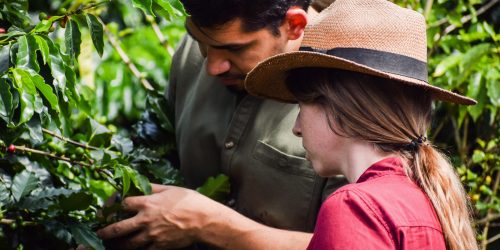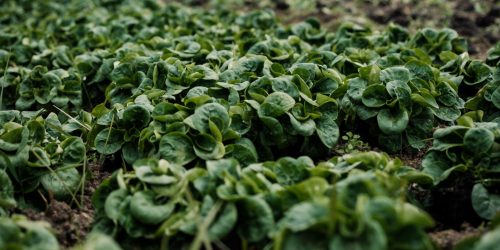We looked at the changes and talked to Jon Hillier, Senior Lecturer in Mathematical Modelling and Global Food Systems at the University of Edinburgh and Chair of the Cool Farm Alliance’s Research Advisory Board, and David McMahon, Product Manager at the Cool Farm Alliance, to understand what they mean for the Cool Farm Tool.
In May 2019, the IPCC released its 2019 Refinement to the 2006 IPCC Guidelines for National Greenhouse Gas Inventories (short: 2019 Refinement), which updated, supplemented and elaborated on the (then) 13 years old 2006 version of the guidelines. The 2019 Refinement follows the same logic and structure as the previous version and consists of 5 thematic volumes. Volume 4 specifically deals with Agriculture, Forestry and Other Land Use (or “AFOLU” in the IPCC terminology).
What method updates can be expected?
The 2019 Refinement includes an updated concept of anthropogenic greenhouse gas emissions and carbon removals for land use, and much of it relates to the way governments construct and report national greenhouse gas inventories. . However, some changes are directly relevant to users of the Cool Farm Tool because many of its algorithms were originally based on IPCC methods. “For the most part, the models used in the 2019 Refinement are still the same”, explains Jon Hillier, Chair of the Cool Farm Alliance’s Research Advisory Board. “But many emission factors have been updated to be more differentiated; and in some cases, also the models have been refined”. In the new CFT 1.0 release coming in February 2022, the following sections will be updated to use the new emission factors from the IPCC 2019 Refinement.
- Paddy rice emission calculations. In addition, a default option for the cultivation period will be added;
- Carbon Biomass change from loss or gain of forest;
- Soil carbon emissions from changing management practice or land use change;
- Wastewater emissions. In addition, new treatment options will be added, and a few will be renamed.
The version 1.0 of the tool will also see an update of the greenhouse warming potentials (GWPs). GWPs express the effect of gases like methane (CH4) and nitrous oxide (N2O) on global warming over a 100-year period, relative to the effect of CO2. As the science progresses, the GWPs are updated by the IPCC. Since the Cool Farm Tool’s inception, the IPCC has updated GWPs twice, in the Fifth Assessment Report (2013) and in the Sixth Assessment Report (published between August 2021 and February 2022). In CFT 1.0, the assessments of Cool Farm Tool users will be calculated according to the GWP of the Sixth Assessment Report. For members of the Alliance, an option to choose the version of the GWPs they want to use in their calculations is being considered.
Other updates are not related to the IPCC 2019 Refinement but equally exciting:
- Emissions from field operations (machinery) will use an enhanced method based on horsepower and time with updated factors for 41 existing and 38 new machines.
- Pesticide Emissions will also use updated factors, coming from the World Food Lifecycle Database (WFLDB). The input categories ‘Seed treatment’ and ‘Post emergence’ are enhanced to calculate emissions based on application rate and active ingredient (i.e. same parameters as soil treatment) and the user may adjust the accuracy of emissions by selecting the type of treatment from pesticide, fungicide, herbicide or insecticide.
- Irrigation energy use can be calculated with a second method based on water volume and location., that uses factors from the World Food Lifecycle Database (WFLDB).
- For dairy & beef, emissions from feed use will be refined in several ways: First, emission factors of existing feed items will update to those of the Global Feed LCA Institute (GFLI). New factors will provide CH4 and N2O breakdowns which will be reported in the results breakdown. Finally, emissions from land use change from soy production can be discounted if an option called ‘Soy Certified’ is selected.
Why are these updates important and how will Cool Farm Alliance members benefit?
“The science and knowledge of climate change and farming is still relatively young and evolving at a fast pace,” explains Jon. “Methods for estimating greenhouse gas emissions are becoming more accurate and precise because there is more and more data to feed the models; and the models themselves are being refined as our understanding of the ecological mechanisms that drive greenhouse gas emissions grows. There is now a much broader scientific foundation for the core processes in the Cool Farm Tool then when the tool was first developed over ten years ago”.
So, Cool Farm Alliance Members will benefit from improved emission estimates which will be more specific to each individual farmer’s situation – and hence provide better guidance on reduction potentials and options. In addition, some errors will be fixed that were known but hadn’t been fixed for the same reason new science hadn’t been implemented – to maintain stability for assessment comparisons over time.
Implementing these changes is technically challenging. “Of course, updates and additions have been made over the years, but changing the core calculations is tricky: If such changes also change the [Cool Farm Tool] results, then that compromises the comparability over time”, says Jon. However,
“Maintaining the current status brings the Cool Farm Tool further away from being [scientifically] state-of-the-art. Thus, it is crucial to fix known errors and keep up with the latest science to ensure the calculations are accurate, consistent, and reliable at this critical juncture in the Decade of Action,” adds David McMahon, Product Manager at the Cool Farm Alliance.
This also explains why the IPCC’s 2019 Refinement is only implemented now: Some of the updates will change the results of Cool Farm Tool calculations. David also explains that, before releasing the updates in February 2022, they have been thoroughly tested to ensure that members can continue to rely on the results and there are no disruptions. Have a look at the key findings from testing users should be aware of.
What will happen to discounted options?
David explains: “Where options are discontinued because the science has moved on and the latest guidance no longer references these, we are using a deprecation approach to minimise the impact on users of the Cool Farm Tool. For example, 14 farm machines are not part of the machinery update. Sludge treatment – anaerobic digestion is not part of the wastewater update. We cannot maintain these deprecated options indefinitely because […] keeping them in the codebase will over time create complexity that will become expensive and high risk to maintain”. However, the Cool Farm Tool development team have thought through how to manage transitions with the lowest possible impact for users. “Where deprecated options occur on an existing assessment, the assessment will continue to be calculated by CFT 1.0 based on the old factor or old method. The option will be marked with the term ‘deprecated’ as a suffix on the option name”, says David. The removal of deprecated items will be delivered as part of the CFT 2.0 implementation on 1 February 2023.
The coming February 2022 release is part of the Cool Farm’s new development strategy, with major releases annually, and fortnightly minor updates. These minor updates will not affect existing calculations but are incremental and may nonetheless offer users improved options: For instance, adding biochar and feed additives.
And more is in store for CFT 2.0, to be released in February 2023. “We have been working with Cool Farm Alliance member Yara on an improved N2O model for a while, as well as working on a new soil carbon model”, reveals Jon Hillier. “There has been much scientific progress in both areas since we first developed the Cool Farm Tool. Updating the sub-models for these two important emission sources will bring that latest knowledge directly to farmers and other users of the [Cool Farm] Tool.”
David McMahon says “The new software development process will enable us to respond to new science in a more agile way, while maintaining transparency for Members and users”.









